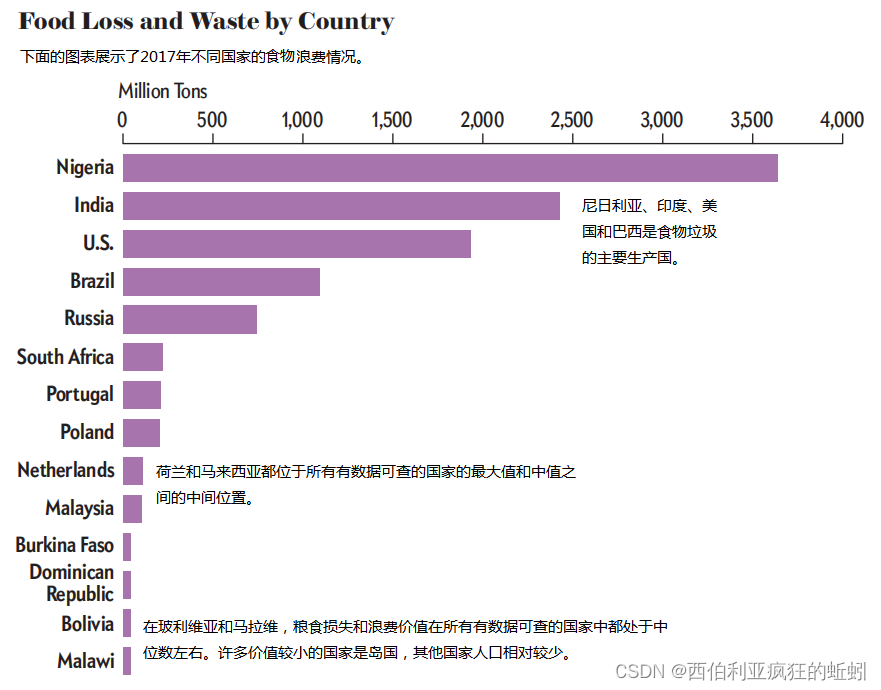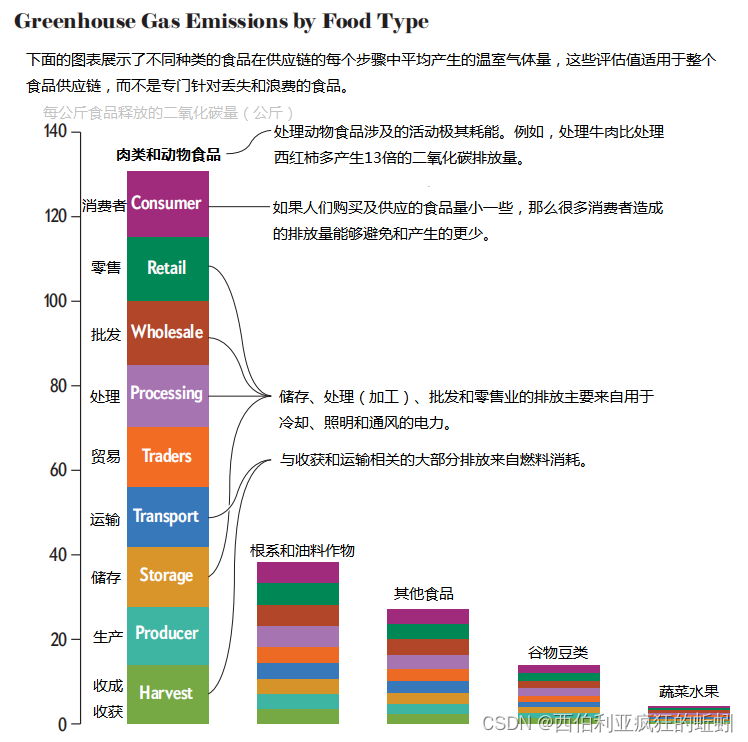Translated from the Scientific American, July/August 2023 issue.
Waste Not
How food waste threatens the planet
- "Waste not"这个标题是一个短语,字面意思是“不浪费”,通常用来强调节约使用和回收利用资源的重要性。
- 本文主要讲述浪费食物是如何威胁地球的。
Paragraph 1
Around a third of human-generated greenhouse gas emissions comes from the global food system, and lost or wasted food is known to contribute some amount —— but it has never been clear to exactly what degree.
翻译:大约有三分之一人类产生的温室气体排放来自于全球的食物系统,并且丢失或浪费食物被认为对此有一些贡献 —— 但是目前为止还不确定具体的影响程度。
解释:
- “human-generated”:人类产生的
- “greenhouse gas emissions”:温室气体排放
- “the global food system”:全球的食物系统
- “lost or wasted food”:掉落或浪费食物
- “contribute some amount”:贡献了一些总量(温室气体排放量)
Now, by following specific foods through their entire life cycle, researchers have determined just how much this wasted food adds to emissions through phases such as harvest, transportation and disposal.
翻译:现在,通过跟踪特定食物的完整生命周期,研究人员们已经确定在收成、运输和处理等阶段,这种浪费食物会增加多少排放。
解释:
- “entire life cycle”:完整的生命周期
- “such as”:例如,所以可能并不是所有的阶段,只是其中一部分
Paragraph 2
For a study in Nature Food, Xunchang Fei of Singapore’s Nanyang Technological University and his colleagues used 164 countries’ food supply data from 2001 to 2017 to estimate emissions across 54 food
commodities and four categories: cereals and pulses; meat and animal products; vegetables and fruits; and root and oil crops.
翻译:在《自然食品》杂志的一项研究中,新加坡南洋理工大学的Xunchang Fei和他的同事使用来自164个国家2001年至2017年的食品供应数据,去估算54个食品及四个类别的温室气体排放:谷类和豆类;肉类和动物产品;蔬菜和水果;根类和油料作物。
解释:
- “food supply data”:食品供应数据
- "estimate ":评估
- “food commodities”:食物商品,即食品
Paragraph 3
Roughly a third of food is lost during harvest, storage and transportation or is wasted by consumers.
翻译:粗略估计有三分之一的食物在收货、存储和运输的时候丢失,或者是被消费者们浪费了。
解释:
- “Roughly a third of food”:粗略地,三分之一的食物
- “is lost … or is wasted”:这两个为并列关系
The team found this food was responsible for greenhouse gases equivalent to 9.3 billion metric tons of carbon dioxide 一 about half the global food system’s total emissions —— in 2017.
翻译:该团队发现2017年这部分食物是温室气体排放的重要原因,它们相当于释放了93亿吨二氧化碳,这大约占全球食品系统总排放量的一半。
解释:
- “was responsible for”:对…负责,是…的原因
- “greenhouse gases”:温室气体,这里主要指温室气体的排放量
- “equivalent to”:相当于
- “carbon dioxide”:二氧化碳
- “metric ton” :公吨,简称吨,国际度量单位,1公吨等于1000千克。ton:吨(英国为2 240磅,即长吨;美国为2 000磅,即短吨)。
Four countries (China, the U.S., lndia and Brazil) contributed 44.3 percent, mainly owing to their dietary habits and large populations.
翻译:中国、美国、印度、巴西这四个国家的排放量占44.3%,主要由于他们的饮食习惯和大量的人口。
Of the four food categories, meat and animal products were the source of almost three quarters of emissions that occurred during the supply-chain phase for food that was ultimately lost.
翻译:4种食品类别中,肉类和动物产品是将近四分之三的温室气体排放的源头,这些温室气体是在供应链期间最终被丢弃的食物产生的。
翻译(中文表达转换):4种食品类别中的“肉类和动物产品”所产生的温室气体,快占了供应链中最终被浪费的食物所产生的温室气体的四分之三。
解释:
- “were the source”:是…的源头/来源/根源/起源/原因
- “almost three quarters of emissions”:将近四分之三(温室气体)的排放
- “during the supply-chain phase”:在供应链阶段的期间
- “for food that was ultimately lost”:对于那些被最终浪费掉的食物
- 这句话指出了在前文列出的这四个食品类别中,肉类和动物产品在最终被浪费的食物在供应链阶段所产生的排放量中占据了很大比例。这个发现强调了肉类和动物产品在食品供应链中的环境影响,并提醒我们要关注减少肉类消费和浪费的重要性。

Paragraph 4
The study considered emissions across nine post farming stages, which vary among regions–for instance, developed countries’ advanced waste-treatment technologies can create fewer emissions.
翻译:该研究分析了农业后的九个阶段,这些阶段的排放量在地区存在差异,例如,发达国家的先进废物处理技术可以减少排放。
解释:
- “across nine post farming stages”:横跨了农业后的九个阶段,包括收获、生产、存储、运输等
- “vary among regions”:区域间总量不同,vary是动词的有别、不同、变化
- “developed countries”:发达国家
- “waste-treatment technologies”:废物处理、废物利用技术
Such intricate details show how “different countries should set different targets for [food loss and waste] reductions," Fei says — such as reducing meat production in some areas, and switching from landfills to anaerobic digestion or composting processes in others.
翻译:这样错综复杂的细节表明,“不同国家应该设置不同的目标来减少食物丢失和浪费,” Fei说,比如在一些地区减少肉类食物生产,在其他地区,用厌氧消化或者堆肥处理来替代填埋。
解释:
-“intricate details”:错综复杂的细节
- “switch from A to B”:从A改(切换、变更)为B
- “landfills”:废物填埋
- “anaerobic digestion”:厌氧消化
- “composting processes”:堆肥过程
Paragraph 5
Food systems expert Prajal Pradhan of the Potsdam Institute for Climate Impact Research in Germany notes that the United Nations Sustainable Development Goals aim to halve food waste in the coming years — which Pradhan says wouldn’t be enough to limit global warming but would be a start.
翻译:德国的波茨坦气候影响研究机构的食品系统专家Prajal Pradhan提示,联合国可持续发展目标是将未来几年的食品浪费减少一半,Pradhan说这不足以阻止全球气候变暖但这会是个(好的)开始。
解释:
- “Food systems expert”:食品系统专家
- “the Potsdam Institute for Climate Impact Research”:波茨坦气候影响研究机构
- “United Nations”:联合国
- “Sustainable Development Goals”:可持续发展目标
- “halve”:减半
Based on this study,he says, emissions could decrease if “high-income countries could focus on saving food discarded by consumers, and low- and middle-income countries could prioritize avoiding food loss during harvesting, processing, storage and transport."
翻译:通过这项研究,他说,如果 “高收入国家能够关注并节约被消费者浪费的食物,中低收入国家能够按重要性避免食物在收获、处理、保存和运输” 温室气体排就放能降低。
—— Deepa Padmanaban
